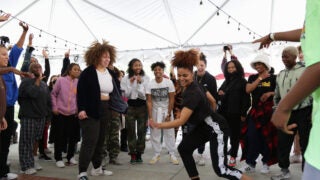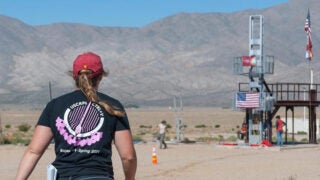
The Little Chapel of Silence at USC’s University Park Campus (Photo/Dustin Snipes; Vintage Photo/Courtesy of USC University Archives)
Where Trojans Go to Pray, Meditate and Reflect: The Little Chapel of Silence
In this busy world, you can find quiet moments of comfort at this timeless USC spot (yes, even remotely).
Tucked away in a quiet corner of the USC University Park Campus is the Trojan Trysting Tree. Through the decades, countless Trojans have come to make “trysts” — vows of faith and commitment — and voice prayers, affirmations, worries, hopes and dreams under its branches.
But this tree drops no leaves and casts no shadows in any courtyards. It’s carved on a wooden mural inside the Little Chapel of Silence, a 225-square-foot nondenominational space open to all. Built next to Town and Gown, the octagonal chapel (seen in this inset photo from the 1960s) has been a haven for quiet reflection, small group devotionals and the occasional restful nap since 1935.
A prayer box at the altar collects any thoughts that visitors wish to leave. Jim Burklo, senior associate dean of religious life, collects the prayer slips twice a year so that they can be read aloud before they’re ceremonially burned.
The small act of putting feelings on slips of paper — especially weighty thoughts or pain from stressful experiences — offers meaning, Burklo says. “You have a different relationship with an experience once you’ve reflected on it, once you’ve written it down.” It’s one way to process feelings and let them go.
During the pandemic, USC brought the chapel tradition online. Now, no matter where someone is, they can fill out a request form to have their message shared during daily prayers in a virtual Little Chapel of Silence.
Rituals and spiritual gatherings might feel out of reach for many students who are far from the campus and their friends, but USC’s religious leaders recognize that spiritual well-being has never been more important. They’ve launched several projects to bridge the distance. Take spiritual care check-ins, for example. USC students, faculty and staff of any religious background can schedule one-on-one Zoom calls during the semester with faith leaders who have “no agenda other than compassion.”
The Office of Religious and Spiritual Life also posted an online guide to practicing gratitude that offers ways to develop good mental health habits. USC’s religious and spiritual student groups have contributed as well, producing introductory videos to share faith resources and positive messages — a way to provide support and fellowship until they can return to campus.



